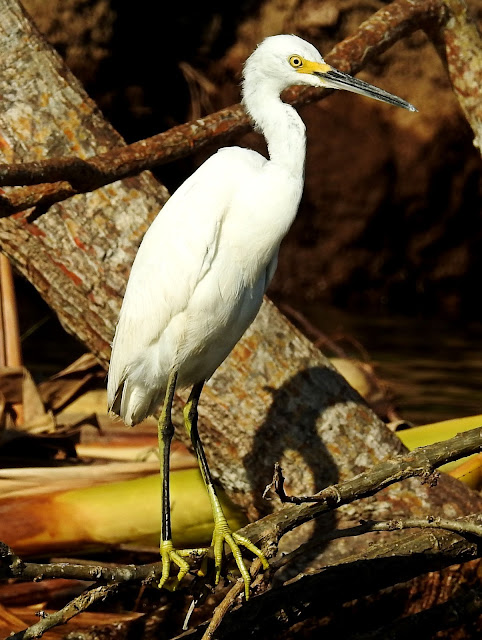The black-cheeked woodpecker (Melanerpes pucherani ) is a resident breeding bird from southeastern Mexico south to western Ecuador.
This woodpecker occurs in the higher levels of wet forests, semi-open woodland and old second growth. It nests in an unlined hole 6–30 m (20–98 ft) high in a dead tree. The clutch is two to four glossy white eggs, incubated by both sexes.
The binomial commemorates the French zoologist Jacques Pucheran.
The black-cheeked woodpecker feeds on insects, but will take substantial quantities of fruit and nectar.
This common and conspicuous species gives a rattling krrrrrl call and both sexes drum on territory.
The adult is 18.5 cm (7.3 in) long and weighs 63 g (2.2 oz). It has black upperparts with white barring on the back, white spotting on the wings and a white rump. The tail is black with some white barring, and the underparts are pale buff-olive with a red central belly. There is a black patch through the eyes and on the cheeks, a yellow forehead, and a red nape. The crown is red in the male and black in the female. Young birds are duller, have less white above and less red on the belly.
Medium-sized woodpecker of evergreen forests and their edges in tropical lowlands. Less numerous than the larger and more conspicuous Golden-fronted Woodpecker, which occurs in the same areas. Distinctive, with a large black mask, white patch behind the eyes, black upperparts with narrow white bars and a large white patch on the rump. The male has an entire red crown. In the female the front is greyish and the back is red.
The Central American woodpecker or black-faced woodpecker ( Melanerpes pucherani ) is a Neotropical bird of the genus Melanerpes whose range extends from Mexico to Peru (recently discovered in the latter country). Its scientific name is a tribute to the French zoologist Jacques Pucheran.
This species is a rather noisy bird and is often seen in large family groups. Its name Melenerpes means black woodpecker and is derived from the Greek roots melas = black and herpes = climber .
The male is 17–19 cm long and weighs 42–68 g. It has a long, black bill with a paler base of the lower mandible and a slightly curved culmen. The iris of its eyes is brown, it has brown to grey orbital skin and greenish-grey legs. The male has a golden-yellow forehead, a red crown and nape, and a broad black mask that surrounds the eyes and continues down the cheeks to the back. It has black upperparts with white barring on the mantle and white spots on the wings. Its rump is white and its tail is black with the central feathers variably barred with white. It has a small white postocular spot, cheeks, chin and upper throat of the same colour. Its breast and lower throat are olive-buff with a grey tint. The rest of its underparts are barred with buff and black with the centre of the belly red. The underside of its wings is also barred with black and white and its tail is yellowish-brown. The female is slightly smaller than the male, with a buff-white to yellow forehead, black rest of the crown and red nape. Juveniles are duller and brownish with more diffuse barring above and paler and less extensive red on the belly.
%2020.jpg)
%2021.jpg)
%2022.jpg)
%20(Florisuga%20mellivora)%2020.jpg)
%20(Florisuga%20mellivora)%2022.jpg)
%20(Florisuga%20mellivora)%2021.jpg)
%2021.jpg)
%2022.jpg)
%20(Icterus%20galbula)%2020.jpg)
%20(Icterus%20galbula)%2021.jpg)
%20(Icterus%20galbula)%2022.jpg)
%20(Icterus%20galbula)%2023.jpg)
%2020.jpg)




%2020.jpg)









%2020.jpg)
%2021.jpg)
%2022.jpg)
%2020.jpg)
%2021.jpg)



%20(Quiscalus%20major)%2018.jpg)
%20(Quiscalus%20major)%2019.jpg)
%20(Quiscalus%20major)%2020.jpg)
%2020.jpg)
%2021.jpg)
%2020.jpg)
%2021.jpg)
%2022.jpg)



